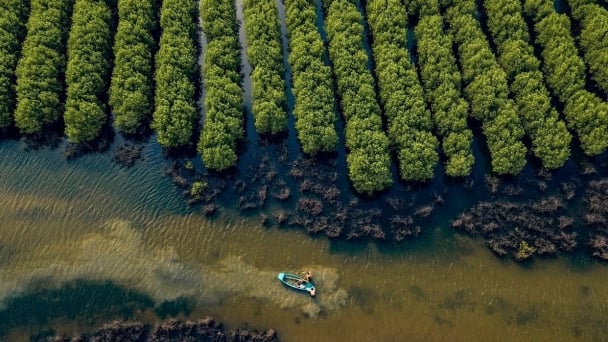June 17, 2025 | 07:26 GMT +7
June 17, 2025 | 07:26 GMT +7
Hotline: 0913.378.918
June 17, 2025 | 07:26 GMT +7
Hotline: 0913.378.918

Harvested black tiger shrimp in Ca Mau. Photo: Son Trang.
Prior to the year 2012, among the varieties of shrimp exported from Vietnam (including black tiger shrimp, whiteleg shrimp, lobster, and other shrimp species), black tiger shrimp consistently held the top position in terms of export value. However, with the robust development of whiteleg shrimp farming, from 2013 onwards, black tiger shrimp relinquished this position, descending to the second position in the overall export value of Vietnamese shrimp.
Despite no longer being the primary export product, black tiger shrimp continues to maintain a significant role within the Vietnamese shrimp industry. Firstly, it remains the largest cultivated shrimp variety. According to the Directorate of Fisheries (Ministry of Agriculture and Rural Development), in 2022, the total area of brackish water shrimp farming in the country reached 737 thousand hectares, of which black tiger shrimp accounted for 622 thousand hectares and whiteleg shrimp for 115 thousand hectares.
Having the largest area also means that a majority of shrimp farmers, especially those in the Mekong Delta region, rely on black tiger shrimp. These are small-scale farming households lacking the financial means and technical conditions to invest in constructing intensive whiteleg shrimp farming facilities. Consequently, they still utilize water surfaces for extensive or improved extensive black tiger shrimp farming, as well as employing integrated models such as shrimp-rice rotation and shrimp farming beneath saltwater mangroves.
On the other hand, Vietnam remains the world's largest producer of black tiger shrimp, followed by countries like Bangladesh, Indonesia, India, China, Philippines, Myanmar, and Madagascar.
Beyond its production advantage, Vietnamese black tiger shrimp also possesses another significant asset: a substantial number of sustainable certification suppliers. According to Mr. Tran Van Cong, Agricultural Counselor of Vietnam in Belgium and the EU, the primary suppliers of black tiger shrimp to Europe are Vietnam and Bangladesh. In this context, Vietnamese black tiger shrimp enters premium distribution systems due to its ASC certification. Conversely, Bangladesh's black tiger shrimp, lacking this certification, mainly enters low-tier distribution systems.
This year, amidst a global decline in shrimp exports due to high inflation and economic difficulties, black tiger shrimp exports have demonstrated positive growth in certain key markets.
According to the Vietnam Association of Seafood Exporters and Producers (VASEP), in the first six months of this year, Vietnam's shrimp exports to China and Hong Kong only reached 280 million USD, a 16% decrease compared to the same period.
However, while shrimp exports to China and Hong Kong declined, black tiger shrimp exports to these markets increased by 30%. In the composition of shrimp exports to China and Hong Kong during the first half of this year, black tiger shrimp ranked second after whiteleg shrimp, comprising a share of 25.3%.

Black tiger shrimp used to be the top-1 exporting shrimp of Vietnam. Photo: Son Trang.
The export prices of black tiger shrimp are also significantly higher compared to whiteleg shrimp. In the first half of 2023, the average export price of Vietnamese whiteleg shrimp to China ranged from 4.9 to 7.9 USD/kg, while the average export price of Vietnamese black tiger shrimp to this market ranged from 8.2 to 13.8 USD/kg.
Also according to VASEP, in the first half of 2023, while the export of whiteleg shrimp to South Korea decreased sharply by 30% compared to the same period, reaching only 140 million USD, the processed black tiger shrimp exports showed a slight increase of 2% in the first six months of this year.
The export prices of black tiger shrimp to South Korea are also notably higher than the prices of whiteleg shrimp. In the first six months of 2023, the average export price of frozen Vietnamese whiteleg shrimp to South Korea ranged from 7.7 to 8.2 USD/kg, whereas the average export price of black tiger shrimp ranged from 12.1 to 14.8 USD/kg.
In the context where Vietnamese whiteleg shrimp faces market competition disadvantages against similar products from India and Ecuador, Vietnam remains the world's top exporter of black tiger shrimp due to its largest production volume and superior quality. Therefore, Mr. Le Van Quang, Chairman of the Board of Directors of Minh Phu Group, believes that a balanced development strategy for black tiger shrimp is needed to enhance competitiveness for the Vietnamese shrimp industry.
Translated by Nguyen Hai Long
![Turning wind and rain into action: [4] Bringing climate bulletins to remote and isolated areas](https://t.ex-cdn.com/nongnghiepmoitruong.vn/608w/files/linhnhp/2025/06/14/1152-z6704423696987_15fd32ffc26d590d204d520c9dac6786-nongnghiep-151141.jpg)
(VAN) The Vietnam Agriculture and Nature Newspaper interviewed Mr. Vu Thai Truong, Acting Head of Climate Change and Environment at UNDP Vietnam, to gain deeper insight into how climate bulletins are delivered to farmers.

(VAN) In Tien Giang, a high-tech shrimp farm has developed a distinctive energy-saving farming model that has yielded promising results.
![Turning wind and rain into action: [3] 300.000 farmers benefit from agro-climatic bulletins](https://t.ex-cdn.com/nongnghiepmoitruong.vn/608w/files/news/2025/06/12/e5a48259d6a262fc3bb3-nongnghiep-125122.jpg)
(VAN) The agro-climatic bulletin has become a valuable tool for farmers in the Mekong Delta. After more than five years of implementation, the initiative is gradually being expanded nationwide.
![Turning wind and rain into action: [2] Providing forecasts to the people](https://t.ex-cdn.com/nongnghiepmoitruong.vn/608w/files/news/2025/06/12/e5a48259d6a262fc3bb3-nongnghiep-103927.jpg)
(VAN) In addition to improving the quality of hydrometeorological forecasts, putting forecast bulletins into practical use is crucial for production and disaster prevention.

(VAN) Blue carbon is receiving attention for its rapid absorption capacity and vast potential. It represents a promising nature-based solution to respond to climate change.
/2025/06/11/3507-1-161904_583.jpg)
(VAN) Seagrass beds and coral reefs serve as 'cradles' that nurture life in the ocean depths, creating rich aquatic resources in Vietnamese waters.
![Turning wind and rain into action: [1] Forecasting for farmers](https://t.ex-cdn.com/nongnghiepmoitruong.vn/608w/files/news/2025/06/11/e5a48259d6a262fc3bb3-nongnghiep-111919.jpg)
(VAN) Weather is no longer just a matter of fate. Forecasts have now become an essential companion for farmers in every crop season.